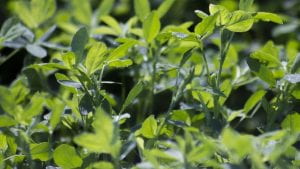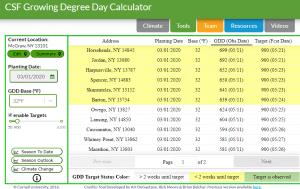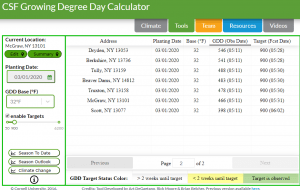This is the SCNY Team’s second full week of monitoring alfalfa heights for first cutting quality in 2020. A full report for the six-county region can be found in the following link: Alfalfa Height Reporting Sheet 5.12.2020.
Team Agronomist, Janice Degni, shares observations from the field this week:
One thing of note this week. Cold weather!! I was hailed on, rained on and snow flurries in the air while I took measurements. I felt like the alfalfa needed hats and mittens.
For counts that went backwards it’s because fields are uneven and we shoot for the taller stalks. Sometimes I go into another section of the field and its slightly different than the previous section measured. Its not that the alfalfa is shrinking but its definitely not jumping taller. Even orchardgrass looked like it was stalled this week.
I saw yellowing alfalfa this week which I attribute to the cold weather.
It’s a very different spring from the last 3, but I trust the measurements and NDF predictions.
This week, we observed only about three-quarters of an inch of growth in alfalfa. Some regions experienced more heat than others, and saw 1-1.5″, but in general growth was slow to non-existent this week.
Cornell’s Climate Smart Farming tool (www.climatesmartfarming.org) can be utilized to determine GDD by location. For grass determination, I selected base 32, and inputted several locations across our region. As John Winchell from Alltech states, all grass fields should be harvested at 900 DGG. Starting at March 1st, a forecasted 900 GDD is shown in the column to the right. I am utilizing this tool alongside our alfalfa height measurements, as many of the fields we measure aren’t to 10″, and the report will not give a target harvest date under 10″.
Jordan (Onondaga County) continues to show high accumulations of GDD in the northern portion of our region. Locations nearby, however, have not experienced such accumulations, and the southern locations for the most part are further along than the northern locations (as would be expected). 900 GDD accumulation looks like around May 21st for the earlier locations (end of next week) for all grass harvest, while later locations are falling about 5 days after that.
Our report next week should reveal alfalfa heights over 10″ in most locations, which will give a targeted harvest date at that point. Crop crews should be getting ready to roll into grass fields as soon as it’s ready – weather forecasts tell that there is one more night of cold, then our average night temps should be closer to what our average days temps have been recently. We’ll continue to monitor GDD accumulations using the Climate Smart Farming tool.
As a reminder, for prediction of NDF content, the height of alfalfa as an indicator is as follows:
- 100% grass stands – cut when nearby alfalfa is 14 inches tall (achieves 50% NDF)
- 50/50 grass/alfalfa stands – cut when nearby alfalfa is 22 inches tall (achieves 44% NDF)
- 100% alfalfa stands – cut when alfalfa is 28 inches tall (achieve 40% NDF)

From Kevin Ganoe, the CNY Dairy, Livestock & Field Crops Team’s Forage Specialist:
Predicted days to cut are based on daily NDF increases for grasses of 1.0% point, 50/50 mixed alfalfa/grass stands of 0.8% points, and alfalfa of 0.5% points and are adjusted for the coming week’s weather. Typically NDF increases about 0.8 to 1.2 per day for grasses, with cooler weather being the lower end of the range and warmer weather being the higher end. For alfalfa, NDF increases about 0.4 to 0.7 per day, also dependent upon warm/cool weather.
Look for our next report of monitoring heights to come out on Wednesday, May 20th. In the meanwhile, if you can’t get out to check your fields, call one of us on the team. We’ll be glad to help out.



